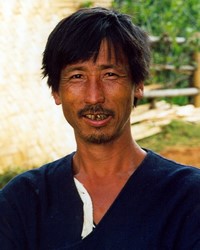Tai Nua, Chinese Shan in Vietnam

Photo Source:
Arian Zwegers - Wikimedia
Creative Commons
|
Send Joshua Project a map of this people group.
|
| People Name: | Tai Nua, Chinese Shan |
| Country: | Vietnam |
| 10/40 Window: | Yes |
| Population: | 113,000 |
| World Population: | 719,000 |
| Primary Language: | Tai Nua |
| Primary Religion: | Buddhism |
| Christian Adherents: | 0.19 % |
| Evangelicals: | 0.17 % |
| Scripture: | Portions |
| Ministry Resources: | No |
| Jesus Film: | Yes |
| Audio Recordings: | Yes |
| People Cluster: | Tai |
| Affinity Bloc: | Southeast Asian Peoples |
| Progress Level: |
|
Introduction / History
The Tai Nua are historically part of the great Tai race of Asia, which dispersed during the past millennia to now inhabit parts of China, Laos, Vietnam, Myanmar, India, and Thailand.
Although the Tai Nua are part of the official Dai nationality in China, they speak their own distinct language. They should not be confused with the identically named but different Tai Nua of Laos. Linguists have pointed out that Tai Nua is "a name given to at least two quite different southwestern branch groups." The Tai Nua profiled here are members of the Southwestern branch of the Tai language family, while the Tai Mao language spoken throughout Dehong Prefecture is similar to the Shan language of Myanmar.
This Tai Nua group is mostly found in southern China, but also in northern Vietnam and Myanmar.
What Are Their Lives Like?
After a Tai Nua wedding ceremony the bridegroom goes to live with his bride's family. Traditionally he must take with him gifts of tea, rice, meat, bananas, four eggs, and two salted fish for his new in-laws. Upon arrival, the village elder takes the packets of tea and rice out to the road and calls on the spirits of heaven and earth to witness the marriage. He then ties a white thread seven times around the wrist of the bride and once around the wrist of the groom to indicate their unbreakable commitment to each other.
What Are Their Beliefs?
The basic unit of Tai Daeng society is the family, which is basically patriarchalPRGRPHor male-dominated. The immediate family usually live together, and there is mutual respect for one another at all levels. They live, eat, and farm together with the women working alongside their husbands. Newly married couples often live with the girl's family until they are able to establish their own separate home.PRGRPHWet rice farming dominates the Tai Daeng economy. Rice is grown both as a dietary staple and for cash sales. The Tai Daeng are noted for sharing the work equally. Both men and women plow, fish, cook, tend to the children, clean the house and wash the clothes.PRGRPHWhen Vietnam made the transition to communism, all levels of Tai society were affected. Groups of independent farmers were organized into "community farms" that share equally in production. In addition, small-scale industrialization led to the entry of farmers into the Vietnamese working class. Communism also brought in more medical schools and better hospitals. This has helped to stop the spread of small pox, cholera, tuberculosis and malaria which were rampant in times past.
What Are Their Needs?
The vast majority of the Tai Daeng practice animism (belief that spirits are located in objects). The people often seek help through supernatural spirits and objects. They also believe in multiple personal souls. Rituals for strengthening the individual p
Prayer Points
Pray for pioneer workers to go to the Tai Nua people in Vietnam with the gospel.
Pray for openness to the gospel among Tai Nua elders and commoners.
Pray for the Lord to send dreams and visions of the Risen Christ to these people who have very little chance to hear His name.
Pray for a disciple making movement to transform Tai Nua communities, plant churches, and discipleship.